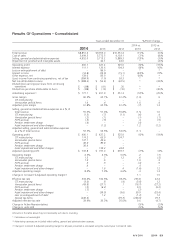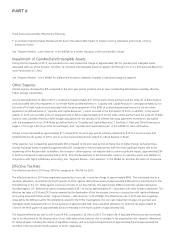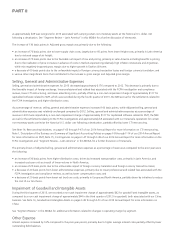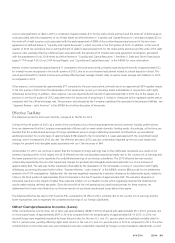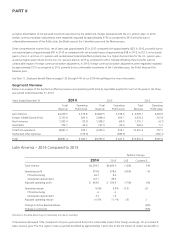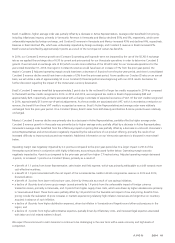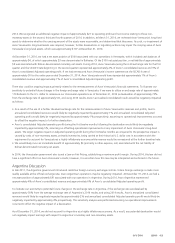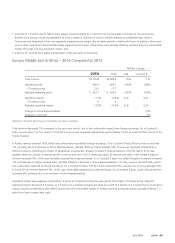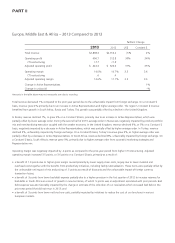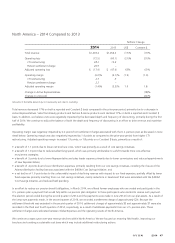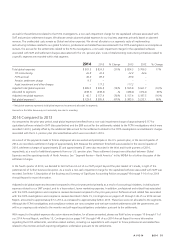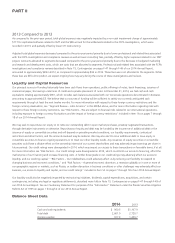Avon 2014 Annual Report Download - page 50
Download and view the complete annual report
Please find page 50 of the 2014 Avon annual report below. You can navigate through the pages in the report by either clicking on the pages listed below, or by using the keyword search tool below to find specific information within the annual report.PART II
Venezuela Discussion
Currency restrictions enacted by the Venezuelan government since 2003 have impacted the ability of Avon Venezuela to obtain foreign
currency at the official rate to pay for imported products. Since 2010, we have been accounting for our operations in Venezuela under
accounting guidance associated with highly inflationary economies. Under U.S. GAAP, the financial statements of a foreign entity operating
in a highly inflationary economy are required to be remeasured as if the functional currency is the company’s reporting currency, the U.S.
dollar. This generally results in translation adjustments, caused by changes in the exchange rate, being reported in earnings currently for
monetary assets (e.g., cash, accounts receivable) and liabilities (e.g., accounts payable, accrued expenses) and requires that different
procedures be used to translate non-monetary assets (e.g., inventories, fixed assets). Non-monetary assets and liabilities are remeasured at
the historical U.S. dollar cost basis. This diverges significantly from the application of accounting rules prior to designation as highly
inflationary accounting, where such gains and losses would have been recognized only in other comprehensive income (shareholders’
equity).
With respect to our 2013 results, effective February 13, 2013, the official exchange rate moved from 4.30 to 6.30, a devaluation of
approximately 32%. As a result of the change in the official rate to 6.30, we recorded an after-tax loss of approximately $51 (approximately
$34 in other expense, net, and approximately $17 in income taxes) in the first quarter of 2013, primarily reflecting the write-down of
monetary assets and liabilities and deferred tax benefits. Additionally, certain non-monetary assets are carried at the historical U.S. dollar cost
subsequent to the devaluation. Therefore, these costs impacted the income statement during 2013 at a disproportionate rate as they were
not devalued based on the new exchange rates, but were expensed at their historical U.S. dollar value. As a result of using the historical U.S.
dollar cost basis of non-monetary assets, such as inventories, acquired prior to the devaluation, 2013 operating profit and net income were
negatively impacted by approximately $45, due to the difference between the historical U.S. dollar cost at the previous official exchange rate
of 4.30 and the new official exchange rate of 6.30. Results for periods prior to 2013 were not impacted by the change in the official rate in
February 2013.
In March 2013, the Venezuelan government announced a foreign exchange system (“SICAD I”) that increased government control over the
allocation of U.S. dollars in the country. The availability of U.S. dollars under the SICAD I market for Avon has been limited to-date. At
December 31, 2014, the SICAD I rate was approximately 12.
In February 2014, the Venezuelan government announced a foreign exchange system (“SICAD II”) which began operating on March 24,
2014. The Venezuelan government had indicated that all companies incorporated or domiciled in Venezuela in all sectors will be allowed to
obtain U.S. dollars through the SICAD II market. The exchange rates established through the SICAD II market fluctuated daily and were
significantly higher than both the official rate and SICAD I rate. In April 2014, we began to access the SICAD II market and were able to
obtain only limited U.S. dollars. While liquidity was limited through the SICAD II market, in comparison to the other available exchange rates
(the official rate and SICAD I rate), it represented the rate which better reflected the economics of Avon Venezuela’s business activity.
Accordingly, we concluded that we should utilize the SICAD II exchange rate to remeasure our Venezuelan operations effective March 31,
2014.
In February 2015, the Venezuelan government announced that the SICAD II market would no longer be available, and a new open market
foreign exchange system (“SIMADI”) was created. In February 2015, the SIMADI exchange rate was approximately 170. We believe that
significant uncertainty exists regarding the foreign exchange mechanisms in Venezuela, as well as how any such mechanisms will operate in
the future and the availability of U.S. dollars under each mechanism. We are still evaluating our future access to funds through the SIMADI
or other similar markets.
At March 31, 2014, the SICAD II exchange rate was approximately 50, as compared to the official exchange rate of 6.30 that we used
previously, which caused the recognition of a devaluation of approximately 88%. As a result of our change to the SICAD II rate, we recorded
an after-tax loss of approximately $42 (approximately $54 in other expense, net, and a benefit of approximately $12 in income taxes) in the
first quarter of 2014, primarily reflecting the write-down of monetary assets and liabilities. At December 31, 2014, the SICAD II exchange
rate was approximately 50.
Additionally, certain non-monetary assets are carried at their historical U.S. dollar cost subsequent to the devaluation. As a result of using the
historical U.S. dollar cost basis of non-monetary assets, such as inventories, these assets continued to be remeasured, following the change
to the SICAD II rate, at the applicable rate at the time of acquisition. As a result, we determined that an adjustment of approximately $116
to cost of sales was needed to reflect certain non-monetary assets at their net realizable value, which was recorded in the first quarter of



